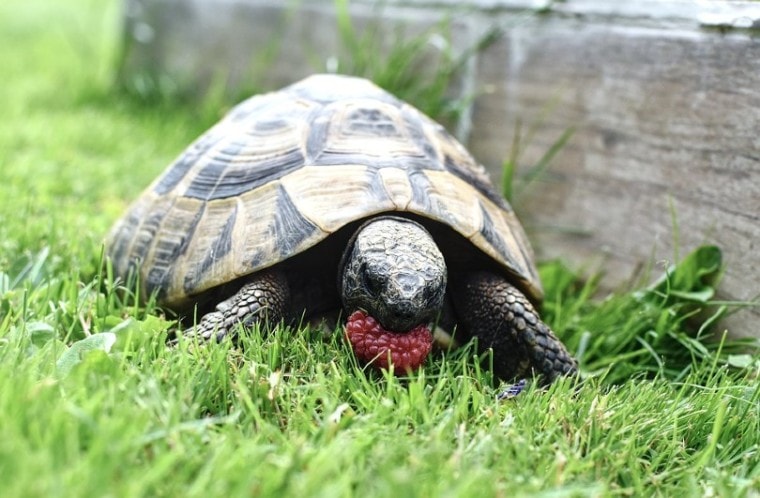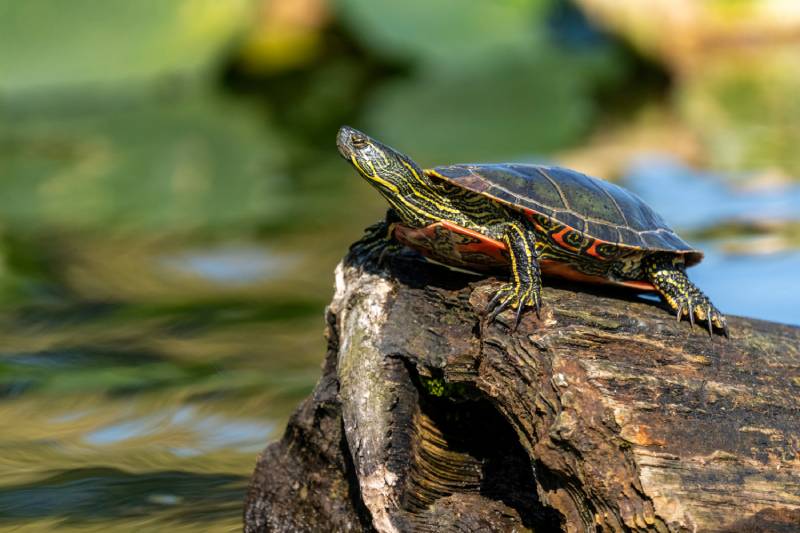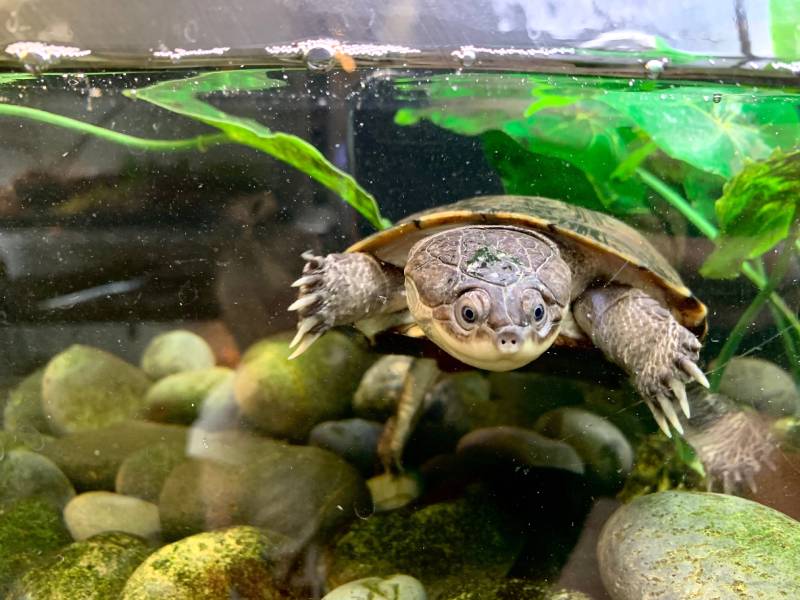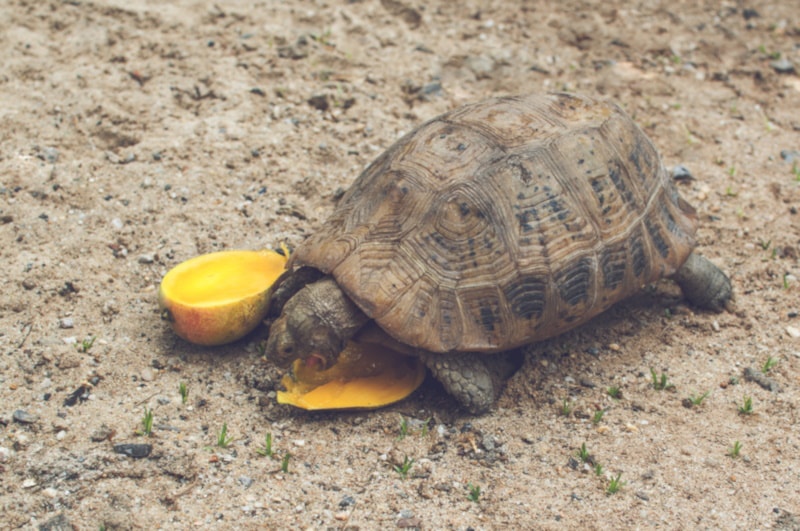
Turtles have slowly (pun intended) become more popular as pets for exotic animal enthusiasts. They are considered “hands-off” pets by most, which, in its own special way, seems to add to their charm. As with all exotic pets, their diet in captivity plays a huge role when it comes to their welfare.
The majority of freshwater turtles are omnivores as adults and opportunistically eat both plant and animal based foods in the wild. However, their diet seems to have a slight bias based on several factors, with the most important one being their age.
This article looks into what turtles eat in nature and how they go about finding food. It will also explore the diet of turtles when they’re kept as pets.
What Turtles Eat in Nature

In nature, freshwater turtles are generally either carnivorous or omnivorous. This usually depends on their species. The following table summarizes the primary dietary habits of freshwater turtles (also known as terrapins) that are kept as pets.
| Scientific Name | Common Name | Diet Type |
| Trachemys scripta elegans | Red-eared slider | Omnivore |
| Terrapene carolina | Florida box turtle | Omnivore |
| Pelomedusa subrufa | African helmeted turtle | Primarily carnivores |
| Chrysemys picta | Painted turtle | Omnivore |
| Trachemys scripta scripta | Yellow-bellied slider | Omnivore |
Almost all turtles lean to a more carnivorous diet when they are young, hunting and eating insects, worms, and other freshwater invertebrates. As adults, turtles classified as omnivores tend to be more accepting of a diet that is predominated by plants, though they may still opportunistically consume animals whenever possible. However, some species, like the yellow-bellied slider, have a nearly exclusive herbivorous diet as an adult.
There are several theories as to why turtles transition their dietary preference in the wild. Broadly speaking, there are two theories that explain this phenomenon. The first is that the turtle would no longer have a high metabolic demand for growth and, therefore, would require less protein in their diet. The second is that as turtles grow, their shell becomes progressively heavier and their ability to hunt is hampered, as they may move slower, be more easily spotted by prey, and may have a harder time catching prey due to their reduced stamina. However, this dietary shift still requires more research from the scientific community to be better understood.
How Turtles Find Food
Many species of turtles are predators that may also opportunistically scavenge on a carcass if they ever come into contact with one. Finding plants is relatively easy, and turtles tend to opportunistically eat various leaves, stems, roots, and fruits that they can forage in their habitat. Turtles have been documented eating over 580 plant species.
Their role as foragers is very important in the ecosystem. Since they don’t migrate, they play a major role in maintaining plant populations in their habitat by acting as natural seed dispersers.
What Turtles Eat as Pets

If you are considering adopting a pet turtle, ensure it is legal to do so where you stay. It is also important to not capture or adopt a wild animal, as this is not conducive with animal welfare and also disrupts local ecosystems tremendously.
Many countries, states, cities, and jurisdictions have limitations on turtle adoption, and certain areas may also have restrictions on what size your turtle can be. Within the US, the FDA prohibits the sale of any pet turtle with a carapace shorter than 4 inches (10 centimeters) on a nationwide basis.
Turtles are not recommended for children, as they are natural carriers of Salmonella. Likewise, they are not considered safe for the elderly, pregnant women, and those with a compromised immune system. Hygiene is of utmost importance when housing any pet reptile.
Individual species of turtles have very distinct characteristics and have very distinct nutritional requirements. In addition, as explained earlier, almost all freshwater turtles have different nutrient requirements depending on their age. Therefore, it isn’t possible to make a broad generalization of a diet plan that works for all turtles. Nonetheless, the nutritional requirements of turtles can be summarized.
All pet turtles do require the following:
For most species of turtles, precise nutritional requirements haven’t been determined. This is because, unlike mammals, the nutritional requirements of a pet turtle must factor in environmental factors as well. Like all reptiles, turtles are cold-blooded animals, and their metabolism is influenced by the temperature of their environment.
Nutrient Overview
The main nutrients to consider in your turtle’s diet are carbohydrates, proteins, and fats.
Protein is very important for growing turtles. Freshwater turtles usually rely on animal sources for their protein. It is estimated that juvenile freshwater turtles require anywhere from 45 – 55% protein in their diet. However, this should also be accompanied by a diet that contains under 15% fat. Otherwise, the high amounts of protein will likely lead to an obese pet or issues with proper shell formation and development.
To prevent overnutrition, most veterinarian nutritionists recommend protein at around 25% for a young, healthy juvenile turtle. This is very important because excess nutrition is very detrimental for turtles. Overfeeding a young turtle will cause their shell to become deformed and appear more cone or pyramid-like. This is also known as shell pyramiding.
The protein and fat requirements of adult turtles vary considerably (depending on several factors), but are generally lower than those of their juvenile counterparts. Adult turtles require more carbohydrates in their diet; however, the exact amounts vary depending on several factors, which includes their reproductive status, brumation status, general health, age, activity levels, and the environmental conditions.
Turtles require a myriad of micronutrients in the form of minerals and vitamins in their diet. However, it is not possible to give a fixed amount for each mineral, as minerals interact with other minerals within the body, and therefore, ratios are an important factor contributing to their requirements. Likewise, though turtles need vitamins, they shouldn’t be overfed, as vitamins can cause issues in excess. Unlike humans, turtles don’t require Vitamin C in their diet.
Commercial Turtle Food
Most of the time, you can feed your turtle commercial turtle food pellets. These are formulated to meet most of the nutritional requirements of a turtle and are considered a good starting point for your turtle’s diet.
Broadly speaking, no turtle pellet is considered nutritionally adequate, so your turtle will likely need their diet supplemented with other food sources.
Prey
Other than the pelleted food, you can also feed prey to your pet turtle, depending on their species. Most freshwater turtles readily accept prey and enjoy chasing them too, adding to their enrichment. Insects are considered the most nutritious and readily available prey source for turtles. They should be gut-loaded about a day or so before being offered to your pet.
Vegetables and Fruits
As adults, most freshwater turtles eat a variety of vegetables. The following vegetables are considered relatively safe and healthy for omnivorous freshwater turtles:
Please note that these vegetables, though safe, should still be offered in a meaningful way and as part of a balanced diet. This list isn’t comprehensive in terms of the vegetables a turtle can eat. All vegetables have various nutritional benefits and drawbacks that should be considered when formulating a meal plan for your pet. It is best to follow your exotic veterinarian’s lead on this matter.
Most turtles should only be offered fruits in very limited quantities, as the nutritional downsides of fruit are considerable. Fruit doesn’t offer turtles any unique nutrient or nutritional benefits that can’t be derived from vegetables. The eastern box turtle is perhaps the most adaptable turtle when it comes to safely eating fruit; however, they are still only fed fruits as a small fraction of their diet (around 15% at most).

Final Thoughts
If you have a pet turtle, it is important to find out exactly what they would eat given their age, environmental conditions, and health status. Turtles have a very complex nutritional profile which consistently varies throughout their life. However, the vast majority of freshwater turtles do share some similarities in terms of the acceptance and safety of certain foods. It is best to start with these safe options and consider modifying them or adding to them only after consulting your veterinarian for guidance and advice that caters to your pet’s needs.
Related Readx:
Featured Image Credit by: SusanneEdele, Pixabay








